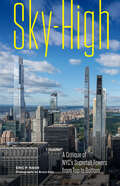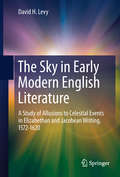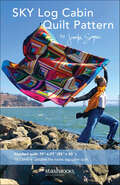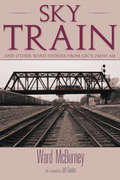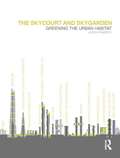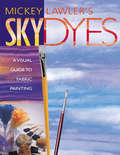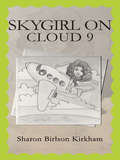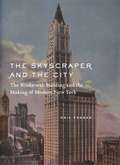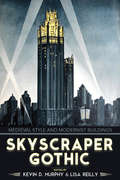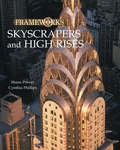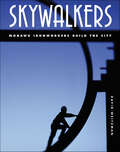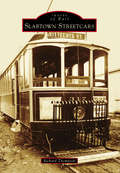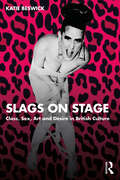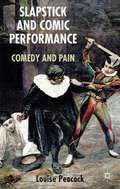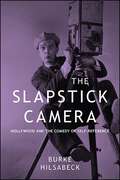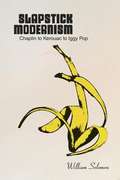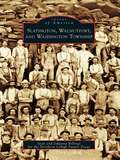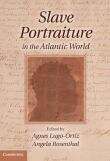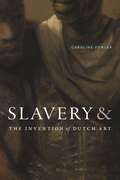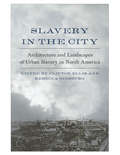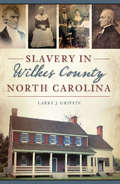- Table View
- List View
Sky-High: A Critique of NYC's Supertall Towers from Top to Bottom
by Eric P. NashPart architectural guidebook and part critique, Sky-High documents the pencil-thin, supertall towers that are transforming New York City's skyline as well as its streets.New York City's penchant for building skyward has reached new heights with its crop of supertall towers—those that rise at least 984 feet above the sidewalk. The city that never sleeps is also the city that never stops building ever higher, from the Woolworth and Chrysler buildings of an earlier race to the top to today's super luxury aeries of 57th Street's Billionaires' Row and the towers of the World Trade complex in Lower Manhattan.Bruce Katz's extraordinary photographs capture a dozen of these self-styled odes to wealth and power, alongside Eric P. Nash's incisive critique documenting the evolution of the skyline, past and present, and the supertalls' transformative effects on the contemporary cityscape. Among the twelve buildings featured are One World Trade Center, Three World Trade Center, 30 Hudson Yards, 35 Hudson Yards, One57, 432 Park Avenue, 53West53, Central Park Tower, and One Vanderbilt.
The Sky in Early Modern English Literature
by David H. LevyAstronomy is not just a subject unto itself. We all look at the sky, and it has always been a fertile source of guidance and inspiration in art, music, and literature. This book explores the sky's appearances in music and art, but focuses most on the sky's enormous presence in early modern English literature. The author concentrates on William Shakespeare, whose references to the sky far exceed the combined total of all his contemporaries. Venturing into the historical context of these references, the book teaches about the Supernovae of 1572 and 1604, the abundant comets of this period, eclipses, astrology and its relation to the night sky at the time, and the early years of the telescope and how the literature of the time relates to it. This book promises to open doors between two great fields of study by inspiring readers to look for their own connections between astronomy and literature, and by helping them to enjoy the night sky itself more completely.
The Sky Is Everywhere
by Jandy NelsonJandy Nelson's beloved, critically adored debut is now an Apple TV+ and A24 original film starring Jason Segel, Cherry Jones, Grace Kaufman, and Jacques Colimon.&“Both a profound meditation on loss and grieving and an exhilarating and very sexy romance." —NPRAdrift after her sister Bailey&’s sudden death, Lennie finds herself torn between quiet, seductive Toby—Bailey&’s boyfriend who shares Lennie&’s grief—and Joe, the new boy in town who bursts with life and musical genius. Each offers Lennie something she desperately needs. One boy helps her remember. The other lets her forget. And she knows if the two of them collide, her whole world will explode. As much a laugh-out-loud celebration of love as a nuanced and poignant portrait of loss, Lennie&’s struggle to sort her own melody out out the noise around her makes for an always honest, often uproarious, and absolutely unforgettable read.
SKY Log Cabin Quilt Pattern
by Jennifer SampouPlay with color and value using ombré fabrics Modern and traditional design cross paths in this stunning Log Cabin quilt. Quilters of every level can create this simple yet versatile quilt. Characterized by strips (logs) surrounding squares, the repeated squares give the quilt pattern depth, and colors create dimension. The block-making approach is thoughtful, with value and color placement studied even though the overall effect has a scrappy appeal. Look closer and see how the blocks create a secondary jumbo star pattern. Jennifer Sampou is known for her gorgeous ombré fabrics, which she incorporates into the Log Cabin quilt. The final quilt size is 77” x 77” with the option of a 93” x 93” quilt included A beautiful quilt that makes the most of your ombré fabrics Tips for building large blocks and making improvisational choices
Sky Train: Stories from CBC's Fresh Air
by Ward Mcburney Jeff GoodesWhat do Northtrop Frye, French dairy cows, and Historic Fort York have in common? They're all part of Ward McBurney's lyric and personal stories from CBC Radio's Fresh Air, which are now available for the first time in print. <p><p> Broadcasting live on Saturday mornings, with Jeff Goodes as host, Ward has been performing his own work for over four years. Sky Train collects 35 of his creative non-fiction pieces, in which Isaac Brock, steam trains, dream trains, Fred Astaire, star fortifications, a tai chi master, truss bridges, ghost soldiers, lost loves, found objects, and, not the least, the author's pet turtle, all find a home. <p> A spirit of companionship and urban curiosity informs these stories, which cherish the marginalia of everyday life, while revealing that the past is always just around the present corner.
The Skycourt and Skygarden: Greening the urban habitat
by Jason PomeroyPopulation increases, advances in technology and the continued trend towards inner-city migration have transformed the traditional city of spaces into the modern city of objects. This has necessitated alternative spatial and technological solutions to replenish those environments that were once so intrinsic to society’s day-to-day interactions and communal activities. This book considers skycourts and skygardens as ‘alternative social spaces’ that form part of a broader multi-level urban infrastructure – seeking to make good the loss of open space within the built environment. Jason Pomeroy begins the discussion with the decline of the public realm, and how the semi-public realm has been incorporated into a spatial hierarchy that supports the primary figurative spaces on the ground or, in their absence, creates them in the sky. He then considers skycourts and skygardens in terms of the social, cultural, economic, environmental, technological and spatial benefits that they provide to the urban habitat. Pomeroy concludes by advocating a new hybrid that can harness the social characteristics of the public domain, but be placed within buildings as an alternative communal space for the 21st century. Using graphics and full colour images throughout, the author explores 40 current and forthcoming skycourt and skygarden projects from around the world, including the Shard (London), Marina Bay Sands (Singapore), the Shanghai Tower (China) and the Lotte Tower (South Korea).
Skydyes: A Visual Guide to Fabric Painting
by Mickey LawlerA veteran fiber artist shares the basics of fabric painting, including step-by-step instructions to master techniques, and a list of necessary supplies.For Mickey Lawler, the sky is never the limit! Mickey’s SKYDYES fabric is well known among quilters and fiber artists as the finest individually hand-painted cotton available.• Perfect for beginning fabric painters, as well as those who have dabbled with fabric paints• Straightforward instructions explain Mickey’s painting techniques• Easy-to-follow exercises show how to create skies, earth, seas, and gardens• Learn how to choose appropriate fabrics, paints, and applicators• Handy “Paint Color and Mixing Chart”• Includes an easy quilt project that uses fabrics you create in the exercisesPraise for Skydyes“Skydyes takes an easygoing tutorial approach to teach quilters new aspects of their craft. Known for her beautiful hand-painted cotton fabrics, Lawler here teaches the art of fabric painting to those who would rather paint their own than buy custom-painted fabric. . . . An excellent choice.” —Library Journal
“Skygirl On Cloud 9”
by Sharon Birlson Kirkham"Skygirl On Cloud 9" is an entertaining narrative of the amazing globe-trekking adventures of fllight attendant Sharon Birlson Kirkham. Each amusing account recalls one of the exciting opportunities Sharon and her husband Cary have experienced through-out her career, and since. While she says they've done their best to see as much as possible, "the world is a really big place. There are hundreds more trips to be taken and stories to be written, 'but' there are only 365 days in a year...."
The Skyscraper and the City: The Woolworth Building and the Making of Modern New York
by Gail FenskeOnce the world's tallest skyscraper, the Woolworth Building is noted for its striking but incongruous synthesis of Beaux-Arts architecture, fanciful Gothic ornamentation, and audacious steel-framed engineering. Here, in the first history of this great urban landmark, Gail Fenske argues that its design serves as a compelling lens through which to view the distinctive urban culture of Progressive-era New York. Fenske shows here that the building's multiplicity of meanings reflected the cultural contradictions that defined New York City's modernity. For Frank Woolworth--founder of the famous five-and-dime store chain--the building served as a towering trademark, for advocates of the City Beautiful movement it suggested a majestic hotel de ville, for technological enthusiasts it represented the boldest of experiments in vertical construction, and for tenants it provided an evocative setting for high-style consumption. Tourists, meanwhile, experienced a spectacular sightseeing destination and avant-garde artists discovered a twentieth-century future. In emphasizing this faceted significance, Fenske illuminates the process of conceiving, financing, and constructing skyscrapers as well as the mass phenomena of consumerism, marketing, news media, and urban spectatorship that surround them. As the representative example of the skyscraper as a "cathedral of commerce," the Woolworth Building remains a commanding presence in the skyline of lower Manhattan, and the generously illustrated Skyscraper and the City is a worthy testament to its importance in American culture.
The Skyscraper Book
by James Cross GiblinDid you know the first skyscraper was built almost 100 years ago? For centuries men had dreamed of buildings tall enough to scrape the sky. But it wasn't until 1880 that a young architect in Minneapolis drew the first plans for structures with steel skeletons strong enough to support 20, 50, or even 100 stories. He called the buildings "cloud scrapers." And then in 1884 the first skyscraper was built in Chicago. It was only a 10-story structure, but it paved the way for giant buildings to come. This book tells the stories of the tallest, most famous, and most influential skyscrapers, from the earliest ones in Chicago to the new office towers rising in our cities today. It points out the beauty of skyscrapers - and sometimes their ugliness. It explores the urban problems skyscrapers have helped to solve, and others they've helped to create. Striking photographs and detailed line drawings convey the visual impact skyscrapers have made upon our cities - and our lives.
Skyscraper Gothic: Medieval Style and Modernist Buildings
by Kevin D. Murphy and Lisa ReillyOf all building types, the skyscraper strikes observers as the most modern, in terms not only of height but also of boldness, scale, ingenuity, and daring. As a phenomenon born in late nineteenth-century America, it quickly became emblematic of New York, Chicago, and other major cities. Previous studies of these structures have tended to foreground examples of more evincing modernist approaches, while those with styles reminiscent of the great Gothic cathedrals of Europe were initially disparaged as being antimodernist or were simply unacknowledged. Skyscraper Gothic brings together a group of renowned scholars to address the medievalist skyscraper—from flying buttresses to dizzying spires; from the Chicago Tribune Tower to the Woolworth Building in Manhattan.Drawing on archival evidence and period texts to uncover the ways in which patrons and architects came to understand the Gothic as a historic style, the authors explore what the appearance of Gothic forms on radically new buildings meant urbanistically, architecturally, and socially, not only for those who were involved in the actual conceptualization and execution of the projects but also for the critics and the general public who saw the buildings take shape.Contributors:Lisa Reilly on the Gothic skyscraper ● Kevin Murphy on the Trinity and U.S. Realty Buildings ● Gail Fenske on the Woolworth Building ● Joanna Merwood-Salisbury on the Chicago School ● Katherine M. Solomonson on the Tribune Tower ● Carrie Albee on Atlanta City Hall ● Anke Koeth on the Cathedral of Learning ● Christine G. O'Malley on the American Radiator Building
Skyscrapers (Readers)
by Libby RomeroLearn all about the world's most amazing skyscrapers – from the first, to the tallest, to how they're built, and everything in between – in this new National Geographic Kids Reader. The Level 3 text provides accessible, yet wide-ranging, information for fluent readers.
Skyscrapers and High Rises (Frameworks (group 1) Ser.)
by Cynthia Phillips Shana PriwerThis work includes a brief history of skyscrapers as well as chapters on elevators and communications, facades and facing, mechanical and electrical systems, forces of nature, and much more.
Skywalkers: Mohawk Ironworkers Build the City
by David WeitzmanSkyscrapers define the American city. Through a narrative text and gorgeous historical photographs, Skywalkers by David Weitzman explores Native American history and the evolution of structural engineering and architecture, illuminating the Mohawk ironworkers who risked their lives to build our cities and their lasting impact on our urban landscape.
Slabtown Streetcars (Images of Rail)
by Richard ThompsonNo area of Portland, Oregon, played a more important role in street railway history than Northwest Portland and the neighborhood known as Slabtown. In 1872, the city's first streetcars passed close to Slabtown as they headed for a terminus in the North End. Slabtown was also home to the first streetcar manufacturing factory on the West Coast. In fact, until locally built streetcars began to be replaced by trolleys from large national builders in the 1910s, more than half of all rolling stock was manufactured in shops located at opposite ends of Northwest Twenty-third Avenue. All streetcars operating on the west side of the Willamette River, including those used on the seven lines that served Northwest Portland, were stored in Slabtown. When the end finally came in 1950, Slabtown residents were riding two of the last three city lines.
Slags on Stage: Class, Sex, Art and Desire in British Culture
by null Katie BeswickSlags on Stage weaves cultural analysis with poetry and art criticism to explore the concept of the ‘slag’ and its place in contemporary British culture.The book traces the etymology of the word slag through the twentieth and into the twenty-first century, thinking through the ways ‘slag’ speaks to issues of class, sex and desire. Broadly, slag is an insult bound up with women’s sexual reputations – but beyond this it is a ‘key’ word that shapes the ways we debate and understand what it means to be a woman. For women who came of age in the United Kingdom in the late twentieth and early twenty-first centuries ‘slag’ produces complex feelings and has influenced how we have come to know ourselves and understand our sexual and quotidian desires. This book explores the terrain of slag and includes analyses of artworks by artists who have invoked the slag in their practice, including Tracey Emin, Cash Carraway and Michaela Coel. Covering the cultural politics of clothing, motherhood, television representations, sexual assault, sex work and desire, Slags on Stage asks: what role does the ‘slag’ play in British culture? Who is she for? And how have women used sex and sexuality to have their own say in cultures that want to control them?This is a fascinating exploration for students and scholars of British drama, theatre and performance, cultural studies and sociology.
Slapstick and Comic Performance
by Louise PeacockSlapstick comedy has a long and lively history from Greek Theatre to the present day. This book explores the ways in which comic pain and comic violence are performed within slapstick to make the audience laugh. It draws examples from theatre, television and film on both sides of the Atlantic.
The Slapstick Camera: Hollywood and the Comedy of Self-Reference (SUNY series, Horizons of Cinema)
by Burke HilsabeckSlapstick film comedy may be grounded in idiocy and failure, but the genre is far more sophisticated than it initially appears. In this book, Burke Hilsabeck suggests that slapstick is often animated by a philosophical impulse to understand the cinema. He looks closely at movies and gags that represent the conditions and conventions of cinema production and demonstrates that film comedians display a canny and sometimes profound understanding of their medium—from Buster Keaton's encounter with the film screen in Sherlock Jr. (1924) to Harpo Marx's lip-sync turn with a phonograph in Monkey Business (1931) to Jerry Lewis's film-on-film performance in The Errand Boy (1961). The Slapstick Camera follows the observation of philosopher Stanley Cavell that self-reference is one way in which "film exists in a state of philosophy." By moving historically across the studio era, the book looks at a series of comedies that play with the changing technologies and economic practices behind film production and describes how comedians offered their own understanding of the nature of film and filmmaking. Hilsabeck locates the hidden intricacies of Hollywood cinema in a place where one might least expect them—the clowns, idiots, and scoundrels of slapstick comedy.
Slapstick Modernism: Chaplin to Kerouac to Iggy Pop
by William SolomonSlapstick comedy landed like a pie in the face of twentieth-century culture. Pratfalls and nyuk-nyuks percolated alongside literary modernism throughout the 1920s and 1930s before slapstick found explosive expression in postwar literature, experimental film, and popular music. William Solomon charts the origins and evolution of what he calls slapstick modernism --a merging of artistic experimentation with the socially disruptive lunacy made by the likes of Charlie Chaplin. Romping through texts, films, and theory, Solomon embarks on a harum-scarum intellectual odyssey from high modernism to the late modernism of the Beats and Burroughs before a head-on crash into the raw power of punk rock. Throughout, he shows the links between the experimental writers and silent screen performers of the early century, and explores the potent cultural undertaking that drew inspiration from anarchical comedy after World War Two.
Slatington, Walnutport, and Washington Township
by Northern Lehigh Future Focus Johanna Billings Sean BillingsThe photographs in Slatington, Walnutport, and Washington Township show readers what the area looked like from when it was a slate quarrying community through the canal era to the present. Among the views are images of a Lehigh Valley Railroad train accident that led to the demolition of the Slatington station, soapbox derby races down Main Street in Slatington, the Lehigh Canal in Walnutport, and life in the slate quarry towns of Slatedale, Emerald, and Washington Township.
Slaton
by Cathy WhittenSlaton, Texas, has a very rich and interesting history. The journey began in 1911 with the clickety-clack of the railroad track of the Santa Fe Railroad. Slaton was named after local rancher and banker O.L. Slaton on May 11, 1911. It was nicknamed "Tent City" in the beginning, because the first citizens lived in tents while construction began on small framed houses and buildings. June 15, 1911, was the official opening day of the city as people came by train, wagon, and on foot. Soon, the Harvey House restaurant was established, giving not only delicious cuisine but also meals served by attentive and attractive women who became known as the Harvey girls. Slaton became the center of the largest division in the Santa Fe system, servicing four daily northbound and southbound trains between Amarillo and Sweetwater. Today, you still hear the lonesome sound of the Santa Fe rolling through town, and the Harvey House is still open to the public. Slaton is a small West Texas community of approximately 6,129 citizens and is located 15 miles southeast of Lubbock.
Slave Portraiture in the Atlantic World
by Agnes Lugo-Ortiz Angela RosenthalSlave Portraiture in the Atlantic World is the first book to focus on the individualized portrayal of enslaved people from the time of Europe's full engagement with plantation slavery in the late sixteenth century to its final official abolition in Brazil in 1888. While this period saw the emergence of portraiture as a major field of representation in Western art, "slave" and "portraiture" as categories appear to be mutually exclusive. On the one hand, the logic of chattel slavery sought to render the slave's body as an instrument for production, as the site of a non-subject. Portraiture, on the contrary, privileged the face as the primary visual matrix for the representation of a distinct individuality. The essays in this volume address this apparent paradox of "slave portraits" from a variety of interdisciplinary perspectives. They probe the historical conditions that made the creation of such rare and enigmatic objects possible and explore their implications for a more complex understanding of power relations under slavery.
Slavery and the Invention of Dutch Art
by Caroline FowlerIn Slavery and the Invention of Dutch Art, Caroline Fowler examines the fundamental role of the transatlantic slave trade in the production and evolution of seventeenth-century Dutch art. Whereas the sixteenth-century image debates in Europe engaged with crises around the representation of divinity, Fowler argues that the rise of the transatlantic slave trade created a visual field of uncertainty around picturing the transformation of life into property. Fowler demonstrates how the emergence of landscape, maritime, and botanical painting were deeply intertwined with slavery’s economic expansion. Moreover, she considers how the development of one of the first art markets was inextricable from the trade in human lives as chattel property. Reading seventeenth-century legal theory, natural history, inventories, and political pamphlets alongside contemporary poetry, theory, and philosophy from Black feminism and the African diaspora, Fowler demonstrates that ideas about property, personhood, and citizenship were central to the oeuvres of artists such as Rembrandt van Rijn, Hercules Segers, Frans Post, Johannes Vermeer, and Maria Sibylla Merian and therefore inescapably within slavery’s grasp.
Slavery in the City: Architecture and Landscapes of Urban Slavery in North America
by Clifton Ellis and Rebecca GinsburgCountering the widespread misconception that slavery existed only on plantations, and that urban areas were immune from its impacts, Slavery in the City is the first volume to deal exclusively with the impact of North American slavery on urban design and city life during the antebellum period. This groundbreaking collection of essays brings together studies from diverse disciplines, including architectural history, historical archaeology, geography, and American studies. The contributors analyze urban sites and landscapes that are likewise varied, from the back lots of nineteenth-century Charleston townhouses to movements of enslaved workers through the streets of a small Tennessee town. These essays not only highlight the diversity of the slave experience in the antebellum city and town but also clearly articulate the common experience of conflict inherent in relationships based on power, resistance, and adaptation. Slavery in the City makes significant contributions to our understanding of American slavery and offers an essential guide to any study of slavery and the built environment.
Slavery in Wilkes County, North Carolina (American Heritage)
by Larry J. GriffinSlavery is a tragic chapter in the history of Wilkes County with a lasting legacy. Prominent businessmen and celebrated civic leaders, like General William Lenoir and William Pitt Waugh, were among the county’s largest slaveholders. Judith Williams Barber endured forty-five years of slavery and garnered respect from both white and black residents. Her story is linked to free person of color and noted landowner Henderson Waugh, whose illustrious, slaveholding white father connected the two families—one slave and the other free. Author Larry Griffin takes readers on an emotional journey to separate fact from myth as he chronicles the history of slavery in Wilkes County.
